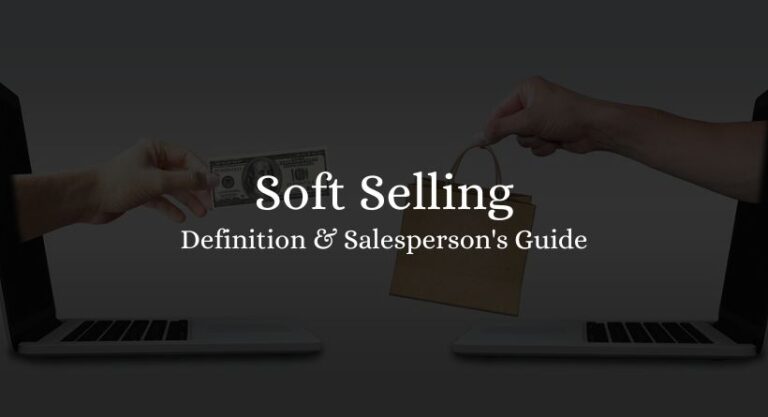Are you tired of traditional sales techniques that leave your customers feeling pressured and skeptical? Do you long for a more effective and customer-centric approach to selling? If so, you’ve come to the right place. In this comprehensive blog post, we will delve into the world of soft selling and provide you with a salesperson’s guide to master this powerful technique.
As a salesperson, you may have encountered challenges when it comes to building trust and rapport with potential customers. Hard-selling tactics often create resistance, leading to lost opportunities and strained relationships. It’s time to acknowledge the limitations of traditional sales methods and explore a fresh approach that aligns with the needs and preferences of today’s consumers.
Fortunately, there is a solution to this predicament. Soft selling offers a refreshing alternative that allows you to establish meaningful connections, foster trust, and ultimately drive more sales. By adopting this approach, you can transform the way you engage with customers, resulting in better outcomes for both parties involved.
Throughout this blog post, we will equip you with the knowledge and strategies necessary to become a proficient practitioner of soft selling. We will demystify the concept, providing a clear definition and exploring its key principles. Additionally, we will share practical tips and techniques that you can implement immediately to enhance your sales approach.
Imagine being able to effortlessly navigate through sales conversations, effortlessly guiding prospects towards a purchase decision while preserving their trust and goodwill. With soft selling, you can revolutionize your sales process and achieve exceptional results without resorting to high-pressure tactics or manipulative strategies.
What is Soft Selling?
Definition of Soft Selling:
Soft selling can be defined as an approach to sales that prioritizes building genuine relationships with customers, focusing on their needs and desires rather than aggressive persuasion tactics. Unlike traditional sales approaches that rely heavily on high-pressure techniques and quick transactions, soft selling takes a more empathetic and customer-centric approach.
Contrasting Soft Selling with Traditional Sales Approaches:
To fully grasp the essence of soft selling, it’s essential to understand how it differs from traditional sales methods. In traditional sales, the emphasis is often placed on closing deals quickly, pushing products or services onto customers, and employing manipulative tactics to generate immediate sales.
Soft selling, on the other hand, takes a more nuanced and thoughtful approach. It recognizes that customers are looking for solutions to their problems, and the salesperson’s role is to guide and assist them in making informed decisions. Soft selling focuses on establishing trust, understanding customer needs, and nurturing long-term relationships rather than solely chasing short-term gains.
Principles of Soft Selling
Building Trust and Rapport:
Trust is the foundation of any successful sales relationship, and soft selling recognizes its paramount importance. By prioritizing trust-building, sales professionals create an environment where customers feel comfortable, valued, and understood. Building rapport involves active listening, open communication, and demonstrating empathy towards customers’ concerns and aspirations.
Customer-Centric Approach:
Soft selling revolves around the customer’s needs, preferences, and goals. Instead of pushing products or services onto customers, the salesperson takes the role of a trusted advisor, guiding them towards the most suitable solution. This customer-centric approach involves thorough understanding of the customer’s pain points, desires, and motivations, and tailoring the sales process accordingly.
Active Listening and Empathy:
Effective communication in soft selling hinges on active listening and empathy. Sales professionals must actively listen to customers’ needs and concerns, allowing them to express themselves fully. By demonstrating empathy and understanding, salespeople can establish a genuine connection and create a personalized experience for each customer.
Value-Based Selling:
In soft selling, the focus is on highlighting the value and benefits that the product or service brings to the customer’s life. Rather than bombarding customers with features and specifications, sales professionals emphasize how the offering solves their problems, improves their lives, or fulfills their desires. This value-based approach enables customers to make informed decisions based on their unique needs and motivations.
Benefits of Soft Selling

Enhanced Customer Satisfaction:
Soft selling prioritizes the customer experience and aims to create long-term satisfaction. By focusing on building relationships, understanding customer needs, and providing value, sales professionals can exceed customer expectations and foster loyalty. Satisfied customers are more likely to become repeat buyers and advocates for your brand.
Long-Term Relationship Building:
Unlike transactional sales approaches, soft selling nurtures long-term relationships with customers. By consistently demonstrating trustworthiness, providing ongoing support, and delivering exceptional service, sales professionals can cultivate enduring connections. These relationships not only lead to repeat business but also open doors to referrals and positive word-of-mouth marketing.
Increased Sales Conversions:
Soft selling may seem counterintuitive to some, as it doesn’t rely on aggressive persuasion or manipulative tactics. However, studies have shown that a customer-centric and empathetic approach actually leads to higher sales conversions. By genuinely understanding and addressing customer needs, sales professionals can create a persuasive and compelling case for their product or service, increasing the likelihood of successful sales outcomes.
Strategies for Implementing Soft Selling
Understanding Customer Needs:
One of the foundational elements of soft selling is gaining a deep understanding of your customers’ needs, desires, and pain points. Invest time in conducting thorough research, asking insightful questions, and actively listening to your customers. By understanding their motivations and challenges, you can tailor your approach and offer personalized solutions that resonate with them.
Effective Communication Techniques:
Soft selling relies on effective communication to build trust and rapport. Hone your listening skills to truly grasp the customer’s perspective, and respond with empathy and understanding. Use clear and concise language to convey the value and benefits of your offering, avoiding jargon or technical terms that might confuse or overwhelm the customer.
Storytelling and Emotional Connection:
Human beings are wired to respond to stories, so leverage the power of storytelling in your soft selling approach. Share anecdotes, case studies, or success stories that demonstrate how your product or service has positively impacted others. Connect emotionally with your customers by illustrating the transformational outcomes they can achieve by choosing your offering.
Overcoming Objections with Softness:
In any sales process, objections are bound to arise. Soft selling approaches objections as opportunities to address concerns and provide reassurance. Instead of dismissing objections or resorting to aggressive tactics, respond with empathy, understanding, and well-thought-out solutions. By approaching objections with softness, you can turn them into stepping stones towards closing the sale.
Stay tuned for the upcoming sections of this blog post, where we will dive deeper into each principle of soft selling and provide you with actionable strategies to implement this approach successfully in your sales practice. Remember, soft selling is not just a technique but a mindset that can transform your interactions with customers and pave the way for sustainable success.
May Also Like Reading: The Letter to Send When You Want Someone’s Business Back Awesome Ways 2023
Conclusion
In conclusion, soft selling offers a transformative approach to sales that prioritizes building trust, understanding customer needs, and fostering long-term relationships. By contrast to traditional sales approaches, soft selling recognizes the value of genuine connections and personalized solutions. By implementing the principles of building trust and rapport, adopting a customer-centric mindset, practicing active listening and empathy, and focusing on value-based selling, you can enhance customer satisfaction, cultivate lasting relationships, and increase sales conversions.
As you embark on your journey to embrace soft selling, remember that it is a continuous process of growth and improvement. The key is to genuinely care about your customers and strive to meet their needs in a meaningful way. By consistently applying the strategies outlined in this blog post and adapting them to your unique selling style, you will position yourself as a trusted advisor and achieve remarkable results in your sales practice.
So, don’t hesitate to embrace the power of soft selling. Begin implementing these principles today and witness the positive impact it can have on your sales success and overall customer satisfaction.







